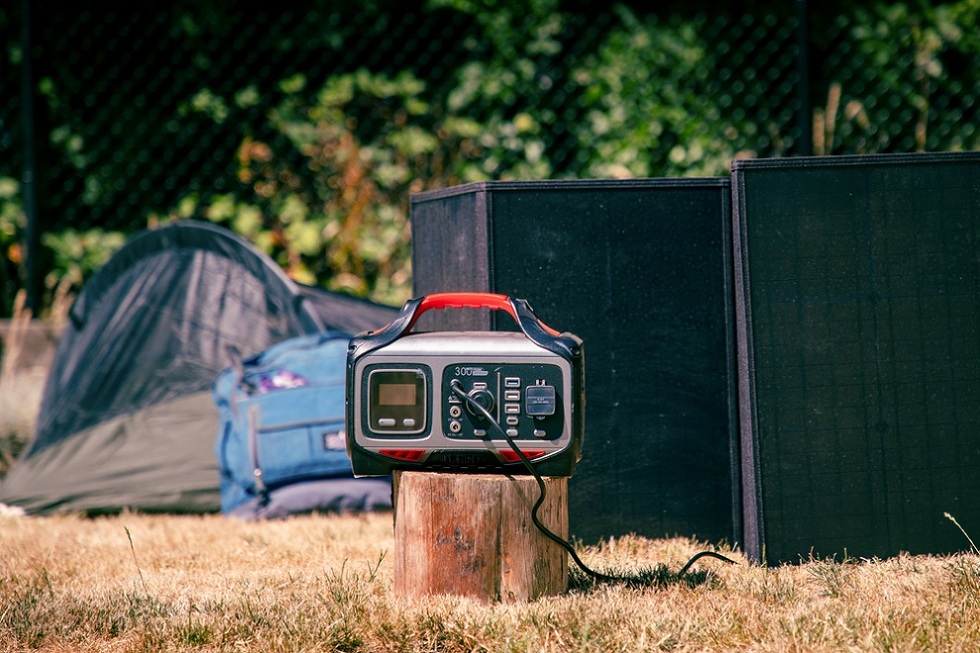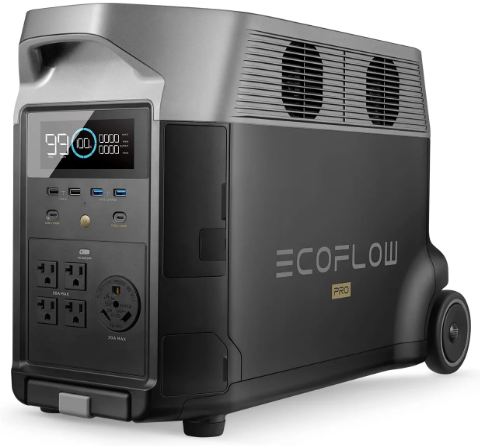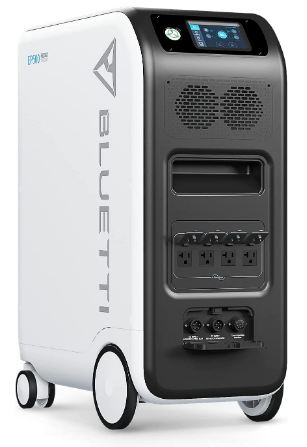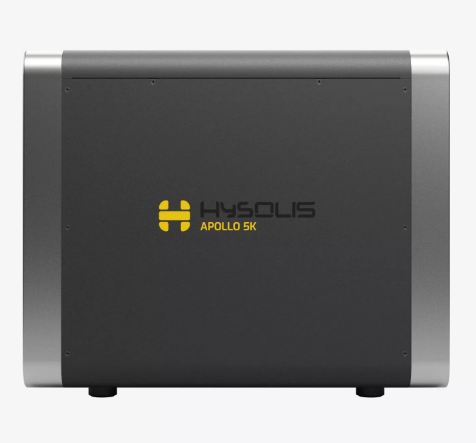Shopping for a 4kW solar generator?
You’ve come to the right place.
What Can A 4kW Solar Generator Power?
A 4kW solar generator is in the top range of solar generator sizes. It’s a good size if you want a solar generator that can provide power backup during emergencies and blackouts. You can also use it for off-grid power in an RV, cabin, outdoor shed, boat and other off-grid situations.
A 4kW solar generator can run almost any household appliance, including large ones like garage heaters, portable ACs (and even some central ACs), and refrigerators.
It’s also powerful enough to run multiple appliances at the same time, which is one of the main reasons it’s great as a home backup or off-grid solar generator.
What’s In This Guide?
In this guide, I review and compare the best 4kW (or thereabouts) solar generators. I also include tips on how to choose the best 4kW solar generator.
If you are looking for a different solar generator size, see my reviews of the best 3kW, 5kW and 10kW solar generators.Best 4kW Solar Generators
- 1Our Top Pick: EcoFlow Delta Pro
- 2Best 240V: Bluetti EP500
- 3Most Expandable: Hysolis Apollo 5K
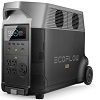
EcoFlow Delta Pro
Our top pick
3600W output, 4500W with X-Boost
3600Wh LiFePO4 battery
Expandable:
25kWh1800W AC input, 1600W solar input
Warranty
5yrs
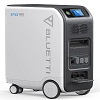
Bluetti EP500
Best 240V
4000W, 240V output
5100Wh LiFePO4 battery
Expandable:
Not expandable600W AC input, 1200W solar input
Warranty
5yrs
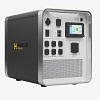
Hysolis Apollo 5K
Most expandable
3000W output, expandable to 27000W
5376 LiFePO4 battery
Expandable:
48.4kWh3000W AC input, 4000W solar input
Warranty
2yrs (3yrs for battery)
1. Our Top Pick: EcoFlow Delta Pro
The EcoFlow Delta Pro has a continuous output of 3600W, but you can increase that to 4500W using the X-Boost feature. If that’s still not enough, you can link two Delta Pros to get 7200W, 240V AC power.
Pros
Cons
Our Review
The EcoFlow Delta Pro is one of our favorite home backup power stations. It has high output, plenty of capacity and outlets for just about any appliance and device.
The Delta Pro comes with a built-in 3600W inverter, so it doesn't quite hit the 4kW mark. But 3600W is still plenty enough to power multiple large appliances.
If you want more than 4000W of power, The EcoFlow Delta Pro has a feature called X-Boost that increases output to 4500W (it works by slightly reducing voltage). So you can power bigger appliances without tripping the solar generator.
Expandable Capacity
The Delta Pro comes with a 3600Wh battery. If you need more capacity than this, the Delta Pro is expandable to 25kWh using additional battery packs.
So you can set up a solar generator kit large enough to keep your home running for days after a blackout.
By the way, the Delta Pro uses LiFePO4 batteries with a lifespan of over 6500 cycles. Even if you cycle (discharge and recharge) the Delta Pro daily, the battery will last for 10 years or more.
Remember you can also expand the output to 7200W by connecting two Delta Pros together using a dual voltage hub. With this setup, max capacity you can expand to is 50kWh (25kWh per Delta Pro).
Multiple Outlets
The EcoFlow Delta Pro has 15 output options. You can plug in almost any electronic, whether it runs on AC or DC power.
Starting with the most important outlets, there are 5 120V AC sockets. One of the outlets is a 30A port that you can plug your RV, boat or van into. Remember these AC outlets produce a combined 3600W or 4500W with X-Boost.
If you need to run DC electronics like a car fridge or an internet router, there are four 12V outlets. These include a pair of DC5521 outputs and a 12V/10A car outlet. There’s also a 12V/30A Anderson port you can use to power your RV’s DC circuit.
To recharge your gadgets and power USB devices, there are 6 USB ports. These include two USB-C 100W ports, two USB-A 18W fast charge ports, and two regular USB-A ports.
Fast Charging
EcoFlow’s X-Stream fast charging technology makes it easy to own a large capacity solar generator like the Delta Pro. You don't have to worry about it taking hours to recharge.
Plug it into an AC outlet and the 1800W charger recharges it in about 3 hours. You can also charge it from a gas generator or the EcoFlow smart generator.
Solar charging is also pretty good. On a sunny day, you can charge the Delta Pro with a 1600W array in 3-4 hours.
You can also charge the Delta Pro at a level 2 EV charging station. This charges it in just 1.7 hours.
Another extra-fast charging option is to combine solar, a wall outlet and the EcoFlow smart generator. This charges the Delta Pro at 6500W.
Issues & Limitations
Relatively Low Solar Input
The 1600W max solar input is good, but it could be better. Large power stations like the Hysolis Apollo 5K and the Bluetti EP500Pro have higher max solar inputs (3000W+), allowing them to charge a lot quicker.
2. Best 240V: Bluetti EP500
If you are shopping for a 4kW, 240V solar generator, I recommend the Bluetti EP500. A single unit produces 2000W, 120V power, but you can connect a second one to get 4000W, 240V power.
Pros
Cons
Our Review
If you have a 240V appliance in your home or RV such as a well pump, AC, garage heater or water heater, you need a solar generator with split phase power output.
Most solar generators, including the Bluetti EP500, sold in the US produce 120V AC power, the same kind that you get from a standard wall outlet.
Unless you import one from Europe, it’s hard to get a 240V power station here. But there’s a way to get 240V power from a 120V solar generator.
Some solar generators like the EP500 have a feature called split phase power. You can connect two EP500 power stations to double their voltage and output. You’ll need the EP300 fusion box.
A single Bluetti EP500 produces 2000W, 120V max. Connect two and you get 4000W, 240V power. You can plug 240V appliances directly into the 220-240V/30A outlet on the fusion box or wire this outlet to a 240V circuit.
Tip: If you need more power, the larger Bluetti EP500Pro has an output of 3000W/120V, 6000W/240V.
Large Capacity
With a capacity of 5100Wh, the Bluetti EP500 is one of the largest solar generators in the market. It’s a great pick if you want lots of capacity without having to buy expansion batteries.
Remember that in a 240V setup, you’ll have double the capacity - 10200Wh. That’s plenty of capacity to run even large appliances like HVAC.
The EP500 uses a LiFePO4 battery with a lifespan of over 3500 cycles to 80% capacity. These batteries can last up to 10 years or more.
The only downside is that LiFePO4 batteries are a lot heavier than Li-ion batteries. A single EP500 power station weighs 167lbs. But it comes with wheels for easier mobility around your home.
Versatile Outlets
The EP500 has four 120V/20A outlets, though you cannot use them when two units are connected. Thankfully, the fusion box comes with additional outlets.
It has one 240V/30A outlet and six 120V/20A outlets. So you can still power both 240V and 120V appliances in split phase power mode.
All the other outputs can be used whether you are in single phase or split phase mode. They include five USB ports (including USB-C PD 100W), two 15W wireless charging pads and four 12V DC ports (including a 12V/30A) RV port.
Note that the EP500 doesn't have a 120V/30A AC port for RVs. If you want that, get the EP500Pro instead. It has both the 12V and 120V RV ports.
Four Ways To Charge
The EP500 offers four recharge options.
You can plug it into a standard wall outlet. Max AC input is 600W, which charges the EP500 in about 9 hours.
You can also plug the EP500 into two wall outlets at the same time to halve charging time. You’ll need to order a second adapter.
If you don't have access to a wall outlet, you can also charge the EP500 from a gas generator.
If you are off-grid or during emergencies, use solar charging. Max solar input is 1200W, which takes about 5 hours to charge the EP500.
The fastest charging option is dual AC + solar charging (1800W), which takes 3.3 hours to recharge the EP500.
Issues & Limitations
Slow Charging
Compared to other high-capacity solar generators, the Bluetti EP500 takes too long to recharge.
The 600W AC input is low compared to the 2000W+ input of other solar generators. Even adding a second adapter doesn't bring the EP500 up to par with similar sized solar generators.
Solar charging is also slow. The 1200W max input is much lower than the 2000W-4000W input many large solar generators accept.
The EP500Pro has faster charging. AC input is 3000W and max solar input is 2400W.
Not Expandable
The 10200Wh total capacity of the Bluetti EP500 (in split phase mode) is probably enough for most people. But if you think you’ll need more capacity in the future, the EP500 is not the best choice.
It is not expandable unlike other large solar generators like the EcoFlow Delta Pro and even Bluetti’s own AC200MAX.
3. Most Expandable: Hysolis Apollo 5K
You can expand the Hysolis Apollo 5K to a max capacity of 48.4kWh and a max output of 27kW, making it one of the most expandable solar generators in the market.
It’s a great pick if you expect your off-grid or backup power needs to change with time. You can start with a single Apollo 5K power station and expand as necessary.
Pros
Cons
Our Review
Solar generators with expandable capacity are nothing new. But the Hysolis Apollo 5K is the first one we’ve seen with expandable output.
The Apollo 5K comes with a 3000W pure sine wave inverter. You can increase output to 6000W by connecting a second Apollo 5K or 9000W by connecting three units.
You can connect up to 9 Apollo 5K units for a max output of 27000W or 27kW. So if you ever need to power your entire home with a solar generator, the Hysolis Apollo 5K can do it.
Expandable Capacity
The Apollo 5K power station comes with a massive 5,376Wh LiFePO4 battery. Using expansion batteries, you can increase this to 48.4kWh, enough to power your home or RV for days.
Multiple Outlets
The Hysolis Apollo 5K has a UPS feature, so you can wire it to your home and it will automatically keep your appliances running in case of a blackout.
You can also plug devices and electronics directly into one of the 16 output options.
These include six 120V/15A ports, one 120V/30A outlet, four 12V ports (including a 30A RV port), and a wireless charging pad.
Super Fast Charging
The Hysolis Apollo 5K has some of the fastest charging speeds I have seen in a solar generator.
Max AC input from a wall outlet is 3000W. This charges the Apollo 5K in a quick two hours. Max solar input is an impressive 4000W, which takes just 90 minutes to charge the Apollo 5K.
You can combine solar and AC charging to get a fast 70-minute recharge time.
Issues & Limitations
If you need at least 4kW of power, you’ll need to order at least two Apollo 5K solar generators. A single one has a 3000W output.
From there, you can only expand output in multiples of 3000 — 6000W, 9000W, 12000W…and so on up to 27000W.
Getting two units will cost you close to $10K.
If that’s beyond your budget, consider getting the EcoFlow Delta Pro instead. A single one can produce up to 4500W.
4kW Solar Generator Buying Guide
What Can You Do With a 4kW Solar Generator?
4kW is a lot of power. Most power stations produce between 300 and 3000 watts of AC power. So a 4000W solar generator is quite powerful. Here’s what you can do with it.
Pros
Cons
Key Features To Consider When Choosing A 4kW Solar Generator
Power Output
You likely won’t find a solar generator with exactly 4000W output. I did not find one myself. So you have to pick the closest output that will meet your needs.
3000-4000W solar generators are plenty. But if you need at least 4000W of power, you may have to go up to 6000W to find a suitable solar generator.
When checking the specs, make sure you differentiate between peak power and continuous power.
Peak power lasts only a few seconds and is meant to provide high startup power for things like pumps and power tools.
The most important number is continuous power. It’s the one that tells you what the solar generator is capable of.
Split Phase 240V Output
If you need to power 240V appliances or if you have a 240V RV or boat, you need a solar generator with split phase 240V output.
This allows you to link two 120V solar generators to get double the power output and voltage.
Capacity & Type of Battery
Next, check how big the battery is. With high output, you also want lots of capacity. Otherwise, the solar generator will run out of juice too quickly.
I recommend getting a solar generator with a capacity of at least 3000Wh. Two of our top picks - the Bluetti EP500 and the Hysolis Apollo 5K - go even higher with capacities of over 5000Wh.
Also, check if you can expand capacity. This will be handy in case you need additional capacity in the future.
Don’t forget to check what kind of battery the solar generator uses. LiFePO4 batteries are the best for large solar generators. They are stable, they charge fast, and they last a heck of a long time.
LiFePO4 batteries are heavy, but this is usually not a problem because 4kW solar generators are not designed to be moved around anyway.
Output Options
Check that the solar generator offers a variety of output options to cover all your appliances and devices.
It should have several AC outlets, at least one 12V DC port, and several USB ports for devices.
If you are getting a solar generator for your RV or boat, look for one with 30A/120V and 30A/12V RV outlets. These make it easy to directly power your entire RV with the solar generator.
Charging Performance
Check the solar and AC input of the solar generator. The higher the input, the faster the solar generator will charge.
For AC charging, an input of 3000W or more is ideal. It allows you to recharge the solar generators in 2-4 hours.
For solar charging, an input of 2000W or more is best. It ensures you can recharge the solar generator in less than a day (ensuring you have a full battery at night).
I highly recommend getting a solar generator with dual AC + solar charging. This greatly reduces charging time, usually to a couple of hours or less.
Frequently Asked Questions
Can a 4kW solar generator power an entire house?
Probably not. If you add up the consumption of all the appliances in your house, it’s likely more than 4kW.
You could wire the solar generator to your home, but you can only run some appliances at the same time to avoid tripping the solar generator.
The best option is to wire the solar generator to just a few circuits that power essential appliances and outlets.
That said, if you have a tiny home or a small off-grid cabin, a 4kW solar generator may be able to power your entire home.
Can a 4kW solar generator run an air conditioner?
Yes, 4kW should be enough to run a max 10,000-11,000 BTU air conditioner. But check the wattage on the AC to confirm.
Also check if the AC uses 120V or 240V power. Some home and RV AC units are set up to run on 240V power. If your is 240V, you’ll need a split phase solar generator.
What appliances can a 4kW solar generator run?
A 4kW solar generator can run any household appliance, including high-power ones like an oven, washer, portable AC, space heater and so on.
You can even run multiple appliances at the same time as long as you do not exceed 4000W draw.

